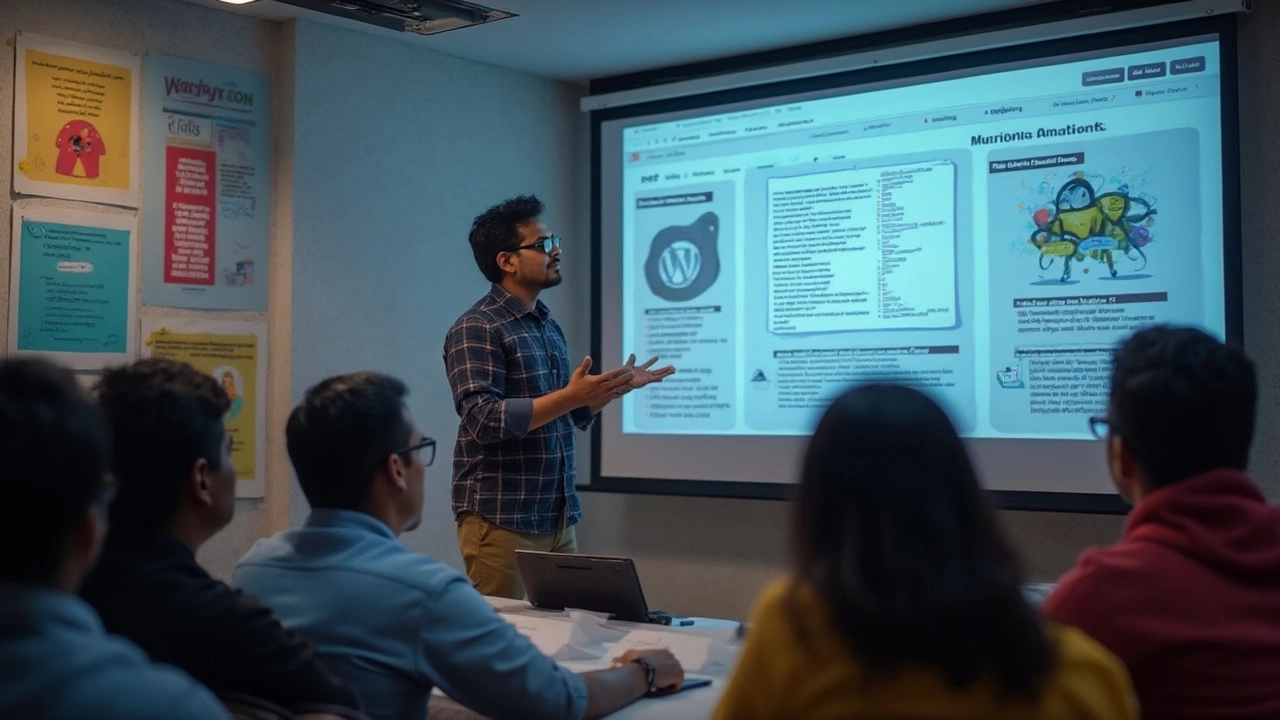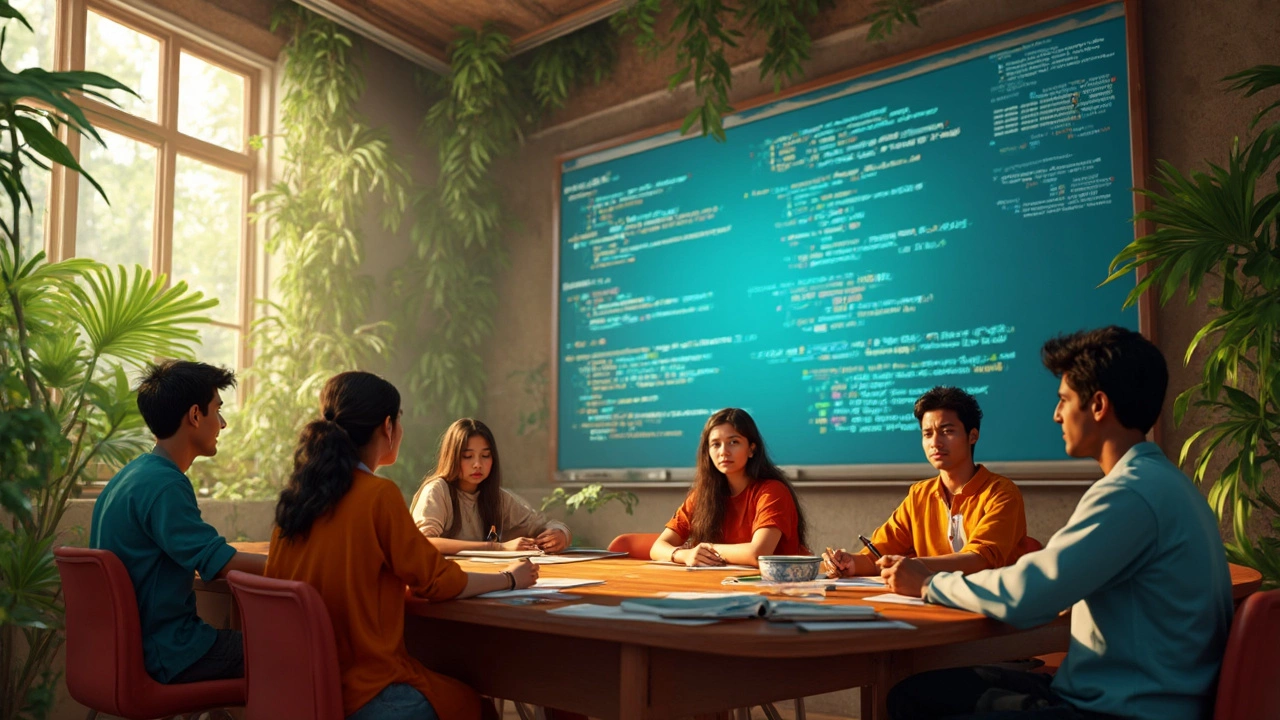Ever wondered what's behind the curtain making WordPress tick? It's PHP, my friend. PHP stands for Hypertext Preprocessor, and it's the scripting language powering most of the web, including WordPress. You might have heard it murmured about at developer meetups or seen it pop up in plugin documentation.
Now, what's cool about PHP is how it brings WordPress to life. Without getting into techy mumbo-jumbo, PHP lets WordPress generate web pages dynamically. So, instead of having hundreds of static HTML files, you get content served to you real-time. It's like your very own website butler, serving fresh pages straight from the kitchen!
Here's an interesting tidbit: back in the day, WordPress only supported MySQL databases. But thanks to PHP's flexibility, developers can now integrate various types of databases. This lets you do all kinds of funky customizations without messing with the core. That's something to think about if you're planning to jazz up your WordPress site.
- What is PHP and Why Does WordPress Use It?
- The Role of PHP in WordPress Themes and Plugins
- Do You Need to Learn PHP for WordPress Development?
- PHP Version Requirements for WordPress
- Tips for Beginners in PHP and WordPress
What is PHP and Why Does WordPress Use It?
Alright, let’s break this down. PHP, which stands for Hypertext Preprocessor, is like the magic behind the scenes for many websites. If you've ever puzzled over why a website can change its content quickly or how clicking a few buttons can pull up your credit card history, PHP's doing a lot of that lifting. It’s a server-side scripting language. This means it runs on the web server before your browser gets a peek.
WordPress leans heavily on PHP to do its thing. Why? Well, it starts with flexibility. Being open-source, PHP is kinda like the open buffet of coding—grab what you like, when you need it. This open nature makes it super customizable, and that's a win for developers. WordPress loves that because it can deliver dynamic web pages that aren't stuck with whatever HTML they were born with. Need a new post? PHP will pick it out of the database in a jiffy.
Here's another reason: it's efficient. Sure, we all like to get things done without hiccups. PHP is quick, which means faster load times and a smoother experience for folks visiting your site. And you know, nobody likes slow. It's a win-win!
If you're into stats, check this out:
| WordPress Sites | Using PHP |
|---|---|
| All WordPress Sites | 100% |
| Total Websites Worldwide | 43% |
Basically, PHP isn’t just decorative. It's the engine that keeps the WordPress train rolling. Without PHP, WordPress would be like a house with no foundations—just pretty walls with nowhere to stand.
And here’s a nugget: While PHP is essential, you don’t need to be a coding guru to run a WordPress site. But dipping your toes in PHP waters can open up worlds of customization and troubleshooting. That means when something breaks (and trust me, it’ll happen), you can do more than just twiddle thumbs.
The Role of PHP in WordPress Themes and Plugins
When you dig into the heart of WordPress, you'll find PHP working its magic behind the scenes, especially in themes and plugins. But what does this mean for you? Well, every time you want your site to look or behave a certain way, you're probably relying on PHP more than you think.
Let's talk themes first. They determine the look and feel of your WordPress site. When you switch themes, you're essentially telling PHP to change the website's attire. Themes take advantage of PHP to pull content from your database and display it in a neat layout. From page headers to footers, PHP controls how your site's elements are presented.
Plugins are the real powerhouses and PHP is their backbone. Fancy a contact form on your site? Or maybe a snazzy photo slider? You'll find PHP scripts doing the heavy lifting. PHP handles plugin functions, making sure they're executed correctly when a visitor lands on your site.
Here’s a quick breakdown of what PHP does in themes and plugins:
- Dynamic Content: It generates dynamic content without needing static HTML pages, keeping things fresh and efficient.
- Customization: With PHP, you can add custom functionalities to your theme or plugins. Want a special widget on your sidebar? That's PHP at work!
- Interactivity: PHP scripts allow for interaction, like submitting forms or processing transactions. It makes your site more than just a pretty face.
Another neat fact: popular plugins often bundle their functionalities in PHP files. Ever peeked inside a WooCommerce installation? It's like a treasure trove of PHP scripts, each doing its part to enhance your online store.
If you're thinking of developing your own theme or plugin, getting cozy with PHP is time well spent. A little bit of PHP knowledge can save you hours of head-scratching.

Do You Need to Learn PHP for WordPress Development?
If you're diving into WordPress development, you might be scratching your head about whether you really need to pick up a thick PHP manual. Let's break it down. While it's totally possible to manage a WordPress site without knowing a stitch of code, understanding the basics of PHP can really make your life easier.
WordPress itself is built on PHP. It's like the Lego that powers everything from the themes to the plugins you use daily. So, having some familiarity can help you customize themes, create snazzy plugins, and troubleshoot issues that might pop up. You know how sometimes you wish the theme just had that one extra feature? A little PHP savvy, and you can make it happen.
Let's look at a scenario: you want to tweak something simple like changing the number of posts displayed on your homepage. Sure, you could hunt for a plugin. But if you know a tad bit of PHP, you can quickly make that adjustment in the theme’s PHP files.
But don’t freak out. You don't have to become a PHP guru to do WordPress development. Most of it is about understanding the basics—like knowing how functions work or getting comfortable with the WordPress Loop. Plus, there are tons of resources and communities willing to help you out when you hit a wall.
So, should you learn PHP if you're getting into WordPress? If you really want to unleash the full potential of WordPress and get things exactly the way you want them, a basic grasp of PHP is super helpful. But don't sweat it if you're starting from scratch. Even small steps into the PHP world can make a big difference in how you shape your site.
PHP Version Requirements for WordPress
If you're diving into the world of WordPress, you're gonna want to get cozy with understanding the PHP version requirements. It's super important because the right PHP version can make your site run smoother and faster, kinda like upgrading from a bicycle to a sports car!
Right now, WordPress recommends running your site on PHP 8.0 or greater. Sure, it supports older versions like 7.4, but using the latest PHP has its perks. For starters, it's got better performance, which means your web pages load faster. Plus, it's safer, minimizing those risky vulnerabilities that hackers love to exploit.
Not sure which version you’re on? Most hosting providers have options in their control panel that show your current PHP version, and you can easily switch versions there. If that’s too geeky for you, your web developer (or a good tutorial video) can walk you through it.
Keep an eye on your plugins and themes, too! Some only work with certain PHP versions. WordPress updates its platform regularly to take advantage of new PHP features and security improvements, so staying current means fewer headaches down the road.
| PHP Version | WordPress Compatibility |
|---|---|
| 8.0+ | Recommended |
| 7.4 | Supported |
| 7.3 and below | Not recommended |
In a nutshell, using the recommended PHP version ensures your WordPress site performs at its best, stays secure, and is compatible with the latest plugins and themes. Just like keeping up with the latest smartphone, staying on top of your PHP version means a better experience all around.

Tips for Beginners in PHP and WordPress
Dipping your toes into PHP and WordPress can seem a bit intimidating at first, but trust me, it's not as scary as it sounds. Even if coding isn't your thing, a little knowledge goes a long way in customizing your WordPress site. Let's break down some tips to make this journey a bit smoother.
Start Small: Don't rush into complex coding projects. Begin by understanding basic PHP syntax. Look at small snippets and understand how they get executed. WordPress themes often come with PHP files—peek into these to see PHP in action.
Use Resources: There's a ton of free guides, forums, and courses online. Websites like W3Schools and even the WordPress Codex itself offer fantastic free tutorials. Getting comfortable with these can demystify a lot of the PHP code you’ll come across.
Experiment with Child Themes: Instead of going headfirst into editing a theme directly, create a 'child theme'. This way, you can mess around with PHP without the fear of breaking everything. It’s like having a playground for your code.
Learn by Doing: Build a simple plugin or modify existing themes. Even if it's something basic, this hands-on experience is invaluable. You'll learn how PHP interacts with other web technologies like HTML, CSS, and JavaScript.
Stay Updated: PHP evolves, and WordPress keeps up. Make sure your WordPress site runs on a supported PHP version. Latest versions come with performance boosts and security fixes. Check out this handy chart to see if you’re up to date:
| PHP Version | WordPress Supported? |
|---|---|
| 7.4 | Yes |
| 8.0 | Yes |
| 8.1 | Yes |
Ask for Help: Don’t hesitate to ask questions in forums or communities when stuck. Other developers love to help, and you’ll often learn little tricks that aren’t in any guide.
Remember, you don’t need to become a PHP wizard to enhance your WordPress site, but having a grasp on the basics will surely give you the upper hand when you’re customizing or troubleshooting your site.



